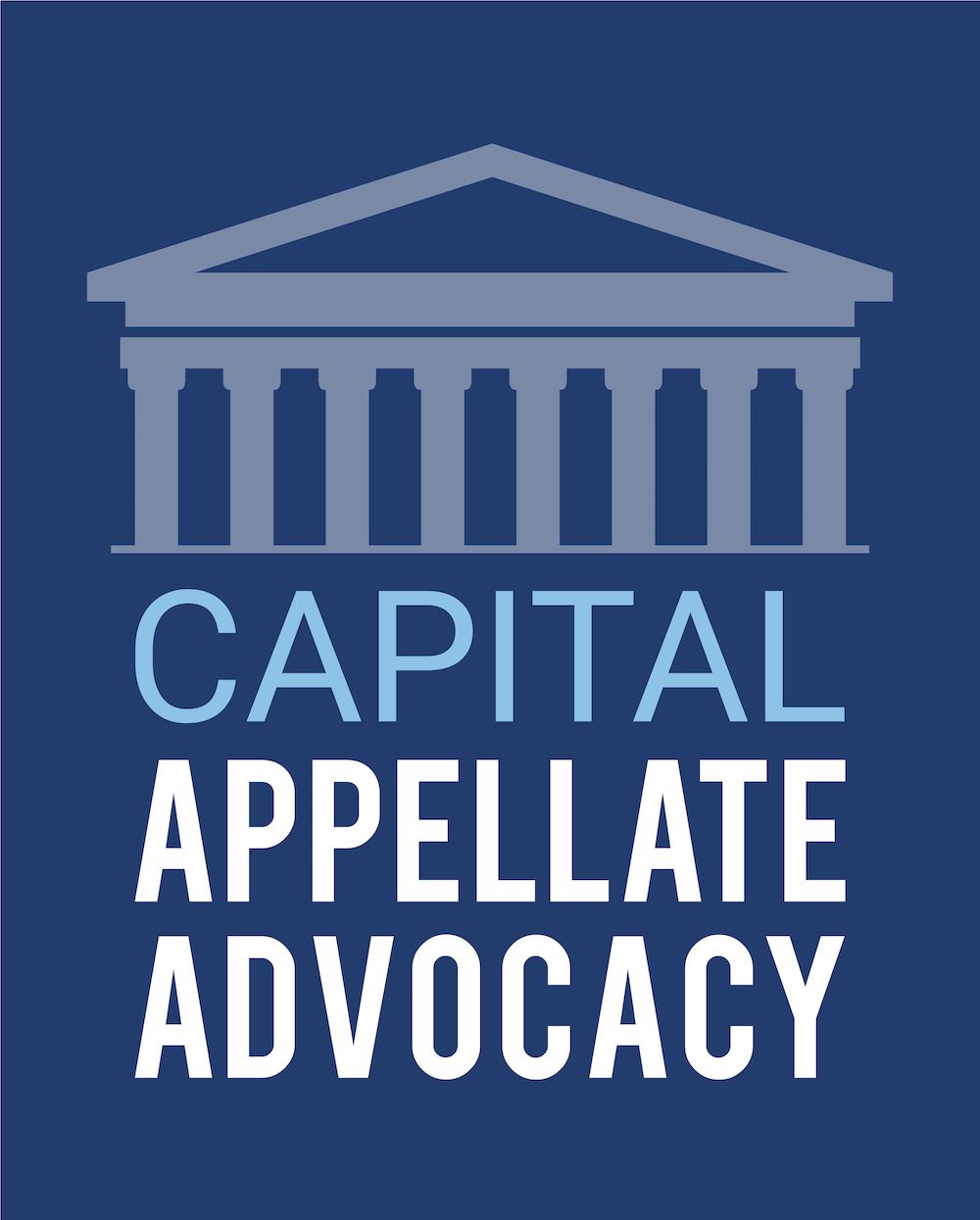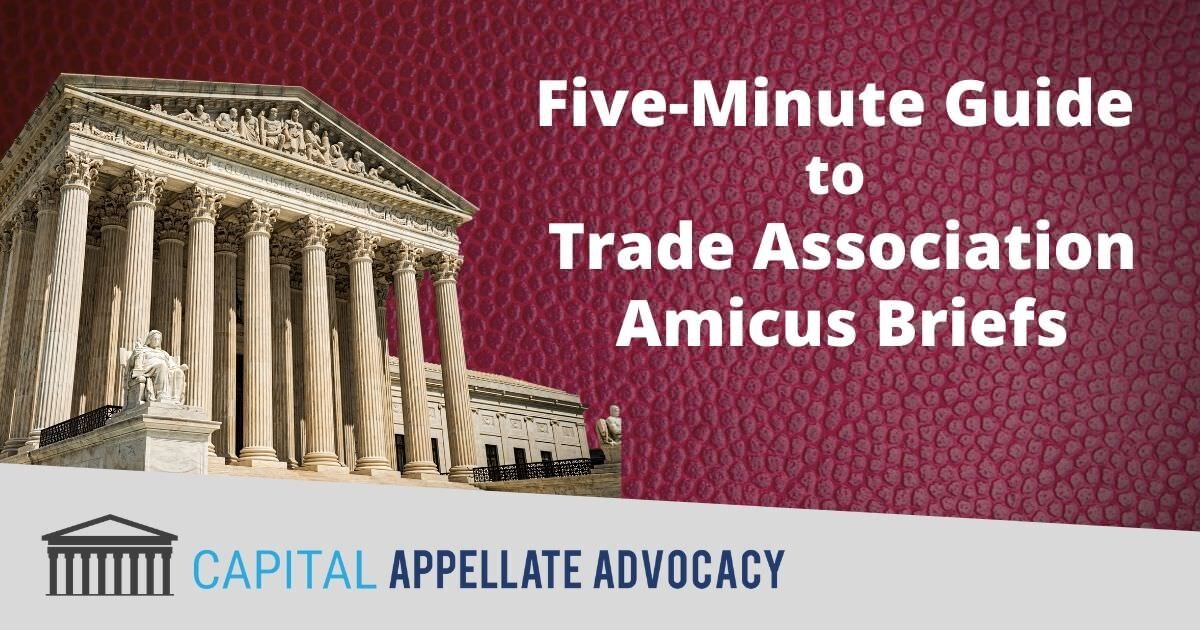Does your association focus on legal, legislative, regulatory, or public policy issues? If so, amicus curiae (“friend of the court”) briefs should be part of your advocacy program.
This Five-Minute Guide to Trade Association Amicus Briefs explains the amicus brief basics that every association should know.

What Is an Amicus Brief?
Amicus curiae briefs are non-party legal briefs. They most often are filed in federal or state appellate courts by trade associations, professional organizations, public interest advocacy groups, individual corporations, and ad hoc coalitions of law professors, legislators, technical experts, or other professionals.
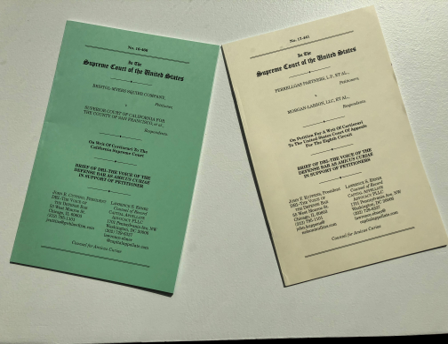
The federal government, and state and local governments, also file amicus briefs.
Every amicus brief begins with an “Interest of the Amicus Curiae” or similarly titled section explaining who is submitting the amicus brief and why.
Effective, well-crafted amicus briefs provide an appellate court with a broader perspective on the legal issues raised by the actual parties in an appeal (i.e., by the Appellant or Petitioner, or the Appellee or Respondent). For example, trade association amicus briefs typically discuss the importance of the issues involved in an appeal, their potential impact on the industry that the association represents, and their public policy implications. And they present legal arguments, or background information, not offered by the parties themselves.
An association’s participation as amicus curiae almost always is limited to the filing of a single brief, sometimes submitted jointly with other associations. Non-governmental amici curiae rarely are afforded the opportunity to present oral argument. Since amici curiae are not actual parties to the litigation, the mere filing of an amicus brief does not subject an association or its members to the court’s judgment.
Why Should My Association File an Amicus Brief?
Amicus curiae briefs give your association a voice in appeals involving legal or policy issues that are important to your members. They are a direct line of communication to appellate courts, including to the Supreme Court of the United States.
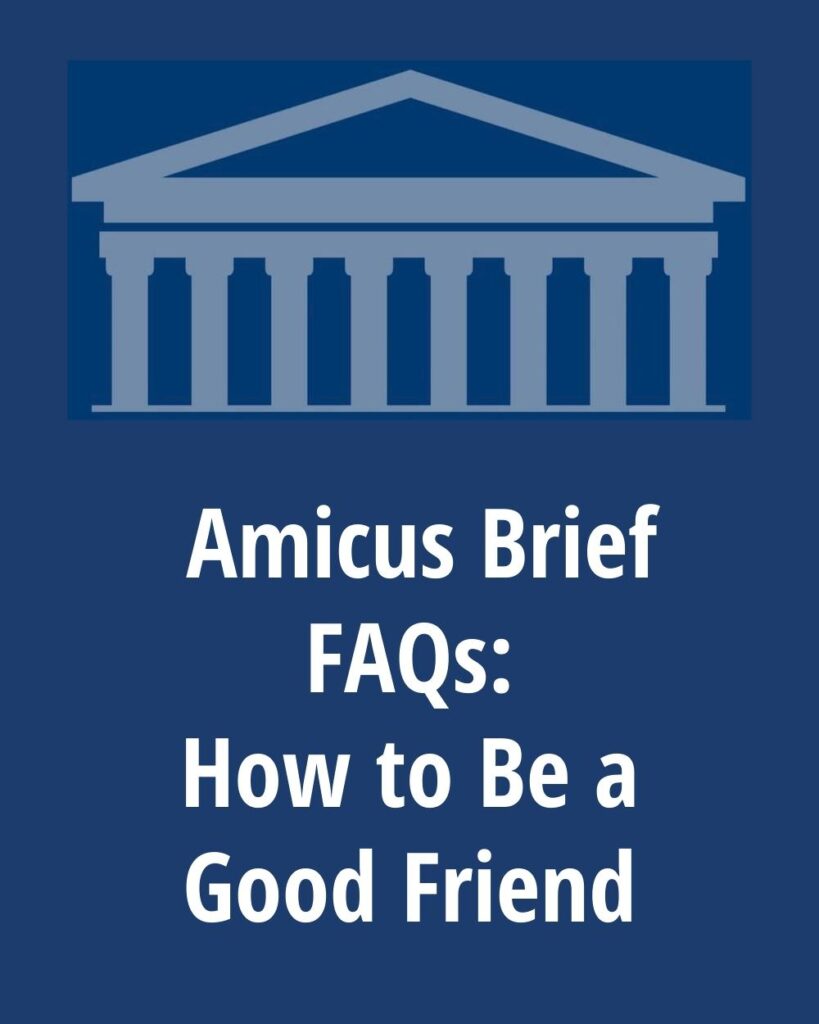
As I wrote in an article for the American Society of Association Executives, Make Amicus Briefs Part of Your Advocacy Program, submission of amicus briefs in carefully selected appeals can provide significant value to an association’s members and supporters. In response to a frequently asked question, I have explained that when many members of an industry share a common interest in an important legal issue pending before a federal or state appellate court, it normally makes sense for their trade association—rather than the companies themselves—to file an amicus brief. The alternative, multiple companies in the same industry filing separate amicus briefs, runs the risk of repetition, or even inconsistency, and can irritate, rather than aid, an appellate court.
In addition to presenting your members’ collective point of view to the Supreme Court or other appellate court on a significant issue, filing an amicus brief—and then disseminating and publicizing it—can be an excellent way to elevate or maintain your association’s profile as a thought leader and advocate. And doing so provides your association with an additional way to educate the media, legislators, regulators, and the public.
Where Can Amicus Briefs Be Filed?
Amicus briefs are a common feature of appellate litigation, and almost always are welcome by appellate courts.
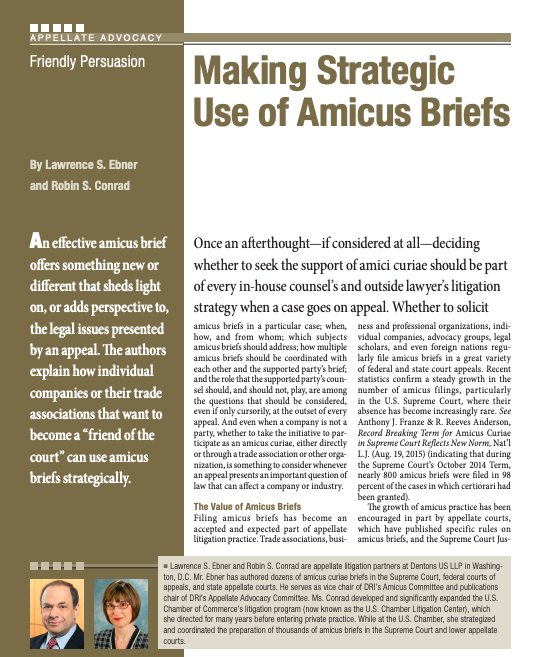
For example, Supreme Court Rule 37.1 states that “[a]n amicus curiae brief that brings to the attention of the Court relevant matter not already brought to its attention by the parties may be of considerable help to the Court.” Making strategic use of amicus briefs is now part of most appellate lawyers’ litigation planning.
In the Supreme Court, most successful certiorari petitions (i.e., petitions for Supreme Court review) are supported by at least one “petition-stage” amicus brief (see example). Many hundreds of petition-stage amicus briefs—which urge the Court to agree to review a case—are filed each year. Petition-stage amicus
briefs are important because the percentage of cases accepted for review is very low. A statistical analysis performed several years ago suggested that amicus support makes a certiorari petition 6 times more likely to be granted. Non-governmental amicus briefs that oppose certiorari, however, are rarely submitted; the conventional wisdom is for certiorari opponents to refrain from calling the Court’s attention to a particular petition.
In cases where Supreme Court review has been granted (approximately 70 cases each year), “merits-stage” amicus briefs (see example)—which focus on how the Court should resolve the legal issues in a case —are commonplace. In fact, about 1,000 merits-stage amicus briefs are filed every year.
Under Federal Rule of Appellate Procedure 29, United States courts of appeals also authorize the filing of amicus briefs in support of the appellant, the appellee, or neither side, in an appeal (see example).
The same is true for state supreme courts (see example), and for some intermediate state appellate courts. Certain state supreme courts, such as the Massachusetts Supreme Judicial Court, routinely invite interested parties to submit amicus briefs on particular issues in pending appeals. These invited amicus briefs not only can help educate members of the court, but also enable broader public participation in the judicial process.
Allowing an amicus brief to be filed while a case is still in a federal district court or state trial court is a matter of judicial discretion. Such briefs are relatively unusual. But at least one federal district court—the U.S. District Court for the District of Columbia—has a local civil rule, Rule 7(o), governing their submission.
When Can Amicus Briefs Be Filed?
U.S. Supreme Court
In most cases, amicus briefs supporting a petition for a writ of certiorari must be filed within 30 days after the case is placed on the Supreme Court’s docket. See Sup. Ct. R. 37.2(a).
It is important to note that this Supreme Court rule requires an amicus curiae to provide the parties’ counsel at least 10 days advance notice of its intention to file a brief.
Time limits, however, do not apply when the Supreme Court issues an order inviting the Solicitor General to file an amicus brief expressing the views of the United States on whether certiorari should be granted. These “CVSG” (“call for the views of the Solicitor General”) orders are issued in cases that appear to implicate significant federal interests even though the federal government is not a party. Although there is no deadline for submission of a CVSG brief, the Solicitor General’s office normally submits all such briefs by the end of the Supreme Court term in which the request for a brief is issued. The Court affords great weight to the Solicitor General’s recommendation on whether review should be granted. As discussed in my article, The United States As Amicus Curiae: Making Uncle Sam Your New Best Friend, both the petitioner’s and respondent’s counsel are afforded the opportunity to meet in advance with the Solicitor General’s office to discuss why the government should or should not recommend Supreme Court review.
In cases where the Supreme Court has granted review, amicus briefs are due within 7 days after the brief of the party being supported is filed. See Sup. Ct. R. 37.3(a). Advance notice for such merits-stage amicus briefs is not required.
The Supreme Court does not grant extensions of time for submission of amicus briefs.
For non-governmental amicus briefs, a motion for leave (i.e., permission) to file an amicus brief must be part of the printed amicus brief booklet, unless the parties’ counsel have consented to the filing of the brief. Consent not only is encouraged, but is usually provided by both sides to an appeal, since the Supreme Court virtually always allows the timely filing of amicus briefs that conform to its rules. There is no justification for the respondent (i.e., the party opposing Supreme Court review) to condition its consent on the opportunity to review a draft of an amicus brief being submitted in support of the certiorari petition.
In October 2019, the Clerk of the Supreme Court issued a Guide To Filing Amicus Curiae Briefs. This friendly guidance from the Supreme Court Clerk summarizes the amicus rules and provides useful information for amicus counsel.
U.S. Courts of Appeals
Amicus briefs must be filed within 7 days after the principal brief of the party being supported is filed. See Fed. R. App. P. 29(a)(6).
Unless the parties have consented, a motion for leave is required. See Fed. R. App. P. 29(a)(2) & (3). Some circuits have adopted local rules governing the format and submission of amicus briefs, and it is important to review those local rules. For example, the D.C. Circuit’s Rule 29(d) states that “[a]mici curiae on the same side must join in a single brief to the extent practicable. . . . Any separate brief for an amicus curiae must contain a certificate of counsel plainly stating why the separate brief is necessary.”
State Appellate Courts
The rules vary from state to state, and court to court.
For example, Rule 8.500 (g) of the California Rules of Court authorize the filing of “amicus letters” by “[a]ny person or entity wanting to support or oppose a petition for review” in the California Supreme Court.
Who Should Draft My Association’s Amicus Brief?
As discussed in my article, Learning the High Art of Amicus Brief Writing, crafting a persuasive amicus brief—one that appellate judges and their law clerks will want to read cover to cover—is a skill that many appellate specialists have mastered.
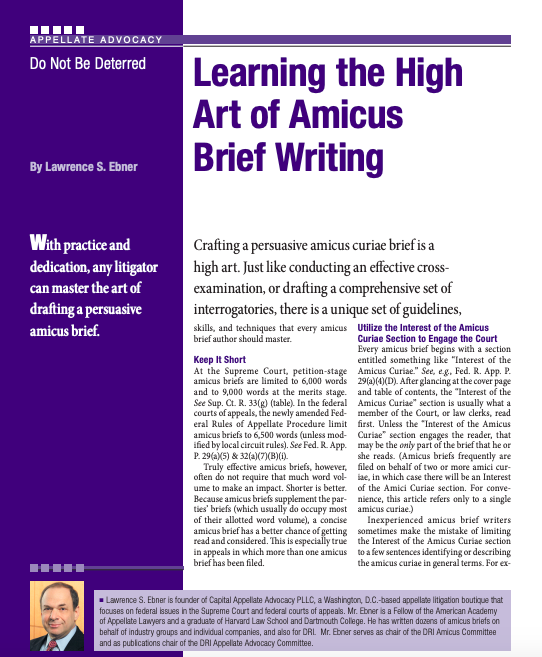
There are several amicus brief drafting guidelines that enhance the readability and impact of amicus briefs.
For example, to meet an appellate court’s standards and expectations, an amicus brief should be written in a seamless style and tone that is more elevated, and somewhat more restrained, than many trial court briefs. While an amicus brief should not be overly academic, it can and should cite scholarly articles and other informational sources that illuminate the legal issues in an appeal.
The Interest of the Amicus Curiae section is very important; it needs to grab the reader’s attention by being more than just a boilerplate description of your association.
Even more important, an amicus brief should not repeat the parties’ legal arguments. See Sup. Ct. R. 37.1. Instead, it should focus on the questions presented from a broader vantage point, and should not get mired in the facts of the case. It must conform to the court’s format and typography requirements, and if possible, should be shorter than the rules allow.
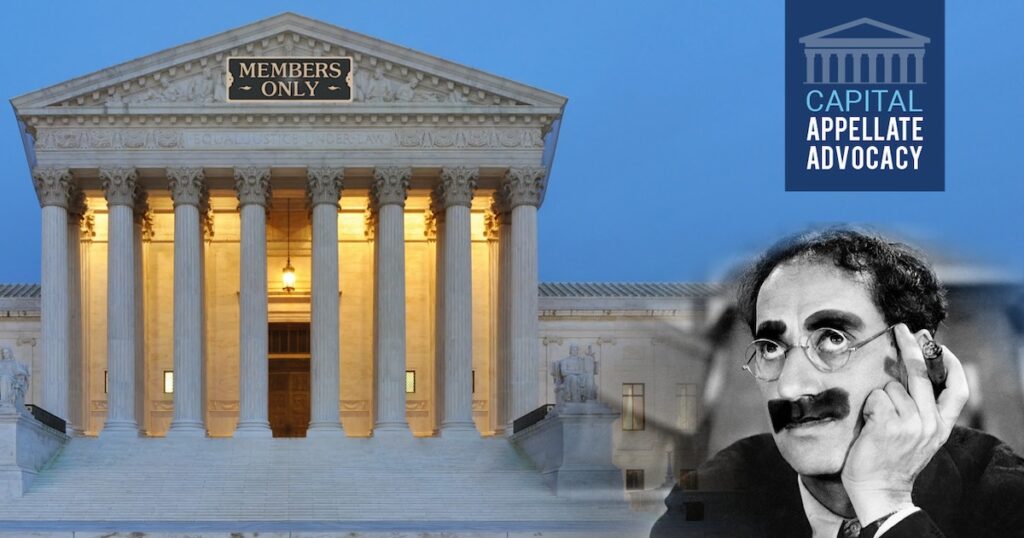
There are many appellate specialists throughout the United States who are well qualified to draft trade association amicus briefs for the Supreme Court, federal courts of appeals, and state appellate courts. My article, Redefining the Supreme Court Bar, argues that drafting effective amicus briefs is an art that any talented appellate attorney can master through hard work and experience.
Beware:
Neither the company or other party that your amicus brief supports, nor its legal counsel, should write, or pay directly or indirectly for, any portion of your amicus brief. This includes members of your association. Rules of the Supreme Court, federal courts of appeals, and many state appellate courts now require amicus briefs to certify that they have not been authored or financed, in whole or part, by a party to the appeal or its attorneys. See Sup. Ct. R. 37.6; Fed. R. App. P. 29(a)(4)(E). The primary purpose of these rules is to deter parties from using amicus briefs as “page extensions” for their own legal arguments. Although such party-authored or party-financed amicus briefs are technically not prohibited, they would have little credibility if written by the supported party’s own attorneys.
It is a common and acceptable practice, however, for a party to solicit and coordinate amicus briefs, to suggest particular amicus topics, and to read and comment on near-final drafts of amicus briefs that are being submitted in their support. In fact, the Advisory Committee Notes accompanying Federal Rule of Appellate Procedure 29 indicate that such coordination aids appellate courts by reducing the amount of duplication among multiple amicus briefs filed in a given case.
How Much Should an Amicus Brief Cost?
Most trade associations have a limited, if any, budget for amicus briefs. This is why paying a lawyer—or worse, a team of lawyers—to research and draft an amicus brief on an hourly rate basis can put amicus briefs out of reach for many associations. Instead, in my view, associations should insist on flat-fee billing, in other words, a fixed legal fee, for preparation of an amicus brief.

As I discussed in a recent article, Flat-Fee Legal Billing Can Liberate Attorneys, fixed flat fees enable appellate litigators—at least those of us who are not part of “Big Law”—to spend as much time as needed to ponder, research, draft, edit, and polish amicus briefs and other types of appellate filings. For this reason, a flat-fee arrangement for an amicus brief can work to an association’s advantage not only by controlling costs, but also by freeing an appellate attorney to produce his or her highest quality work.
Even for appellate specialists, authoring a high-quality amicus brief can be a major undertaking. Nevertheless, I have found that depending on the complexity of the case, $15,000 to $20,000 is a reasonable fixed fee for an experienced, “hands-on” appellate lawyer to prepare an amicus brief. In contrast, a large law firm that assigns a team of two, three, or more lawyers to bill at hourly rates for researching and drafting an amicus brief can rack up a bill several times this amount, sometimes even exceeding six figures.
When associations join together to file a single amicus brief, they often agree to share the cost (legal fees and any printing costs). In these situations, each co-amicus should have a say in who the attorney writing the brief will be; how much that amicus counsel’s fee will be; the order in which the associations will be listed on the cover of the brief and described in the Interest of the Amicus Curiae section; and the approach and content of the brief.
Each association also should be given a reasonable amount of time to review and comment on a draft before the brief is filed. Associations too often are called upon at the eleventh hour to join a brief as co-amicus on a take it or leave it basis. Along the same lines, be wary of attorneys who draft an amicus brief on their own initiative, and then shop it around to associations that can sign on in return for paying a legal fee.
How Can My Association Set Up a Simple Amicus Brief Program?
Here is my key message: Trade associations should take a proactive approach toward amicus briefs. In short, “think amicus.”
At a minimum, your association should have a way to identify and monitor pending appellate cases that may provide potential opportunities for submission of amicus briefs. Amicus opportunities also may arise because you are approached by an association member that is involved in an appeal and wants your amicus support. Or an allied association may contact you because it would like you to join its brief as a co-amicus.
You also will need a mechanism for vetting specific amicus opportunities. This can be as simple as asking your in-house counsel or outside attorney for a recommendation on whether to file. Or, you may want to establish an amicus committee that is composed of some of your members and can promptly review and consider amicus opportunities. Such a committee could adopt ground rules, such as requiring at least 14 days’ advance notice when your association is invited to sign onto another association’s brief, as well as requiring a reasonable opportunity to review and comment on a draft of the brief.
Finally, you should recognize the internal and external trade association profile-building opportunities that filing amicus briefs provide. For example, when you file an amicus brief, consider issuing a press release, as well as posting news about the brief and a link to it on your association’s website, on your LinkedIn page, and in your newsletter or other publications.

About Larry Ebner and Capital Appellate Advocacy
Larry Ebner is founder of Capital Appellate Advocacy PLLC, a nationwide appellate litigation boutique devoted to representing individual businesses and entire industries. During his almost half-century of legal practice, he has authored dozens of amicus briefs, including on behalf of industry trade associations, professional organizations, individual corporations, and even the Republic of France, in the Supreme Court, federal courts of appeals, and state appellate courts.
Larry also has written and spoken extensively on the preparation and strategic use of amicus briefs in appellate litigation. In 2018, he recorded an on-demand webinar, Friendly Persuasion: Drafting and Using High-Impact Amicus Briefs, covering topics such as the role of amicus briefs in appellate litigation, soliciting amicus support, amicus brief content and style, rules governing amicus briefs, and interacting with the United States or state governments when they appear in an appeal as an amicus curiae. Larry’s book chapter, Representing Amici Curiae, included in Strategies For Appellate Litigation published by Thomson Reuters/Aspatore (2014), also discusses practical considerations relating to amicus briefs.
In addition, legal media have called upon Larry to comment on the role of amicus briefs at the Supreme Court and in other appellate litigation.
Larry has been inducted as a Fellow in the American Academy of Appellate Lawyers. In addition, he devotes substantial time to DRI-The Voice of the Defense Bar as Immediate Past Chair of the Amicus Committee, Co-Vice Chair of the Center For Law and Public Policy, and Publications Chair of the Appellate Advocacy Committee.
Following graduation from Dartmouth College and Harvard Law School, Larry began his legal career in the Civil Division of the U.S. Department of Justice. He then spent more than 40 years at the Washington, D.C. office of a national, and then global, law firm, where he was a partner and appellate practice leader. In 2016 Larry decided to launch his own independent, solo practice firm, Capital Appellate Advocacy PLLC.
Larry can be contacted at lawrence.ebner@capitalappellate.com or 202-729-6337.
